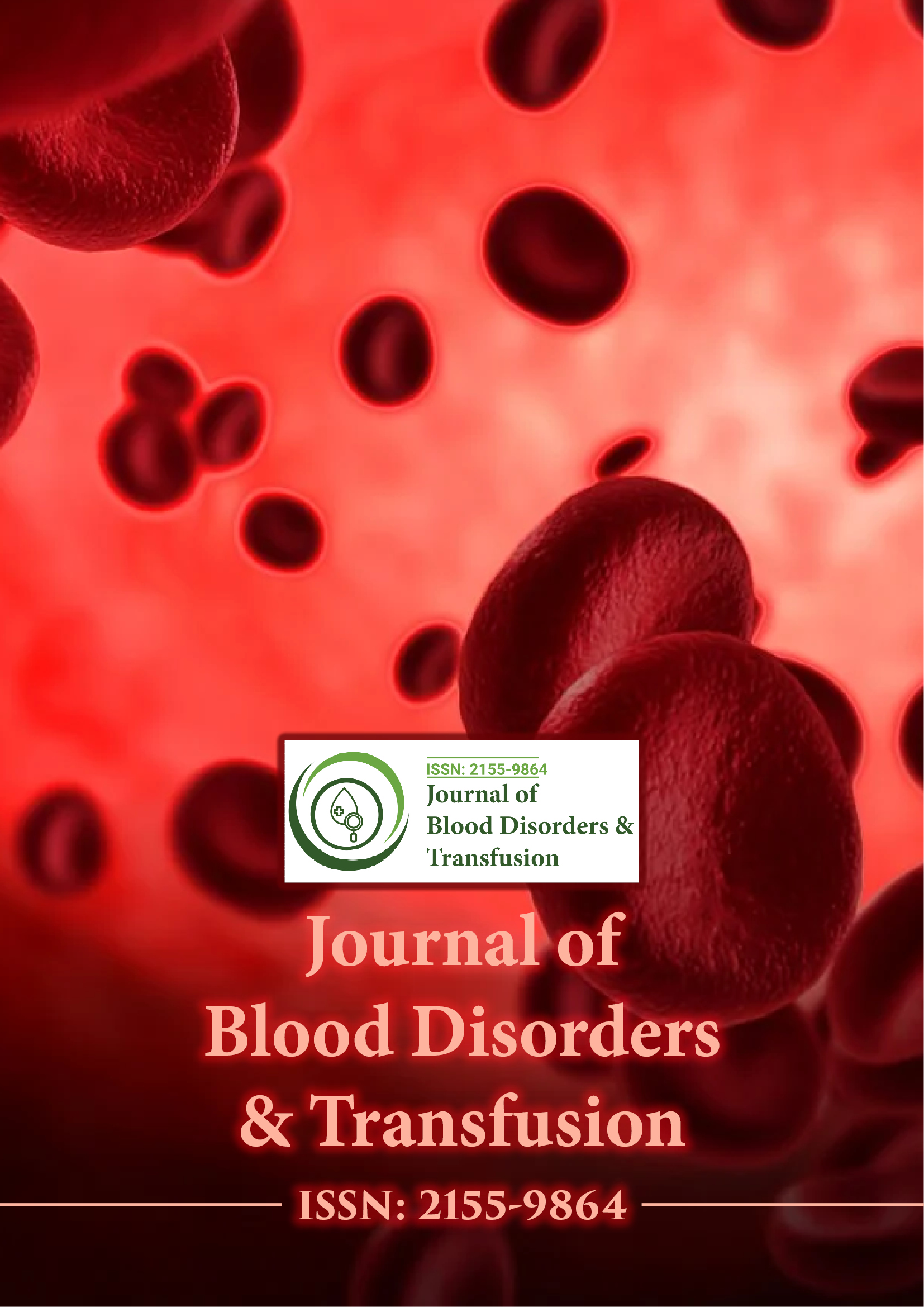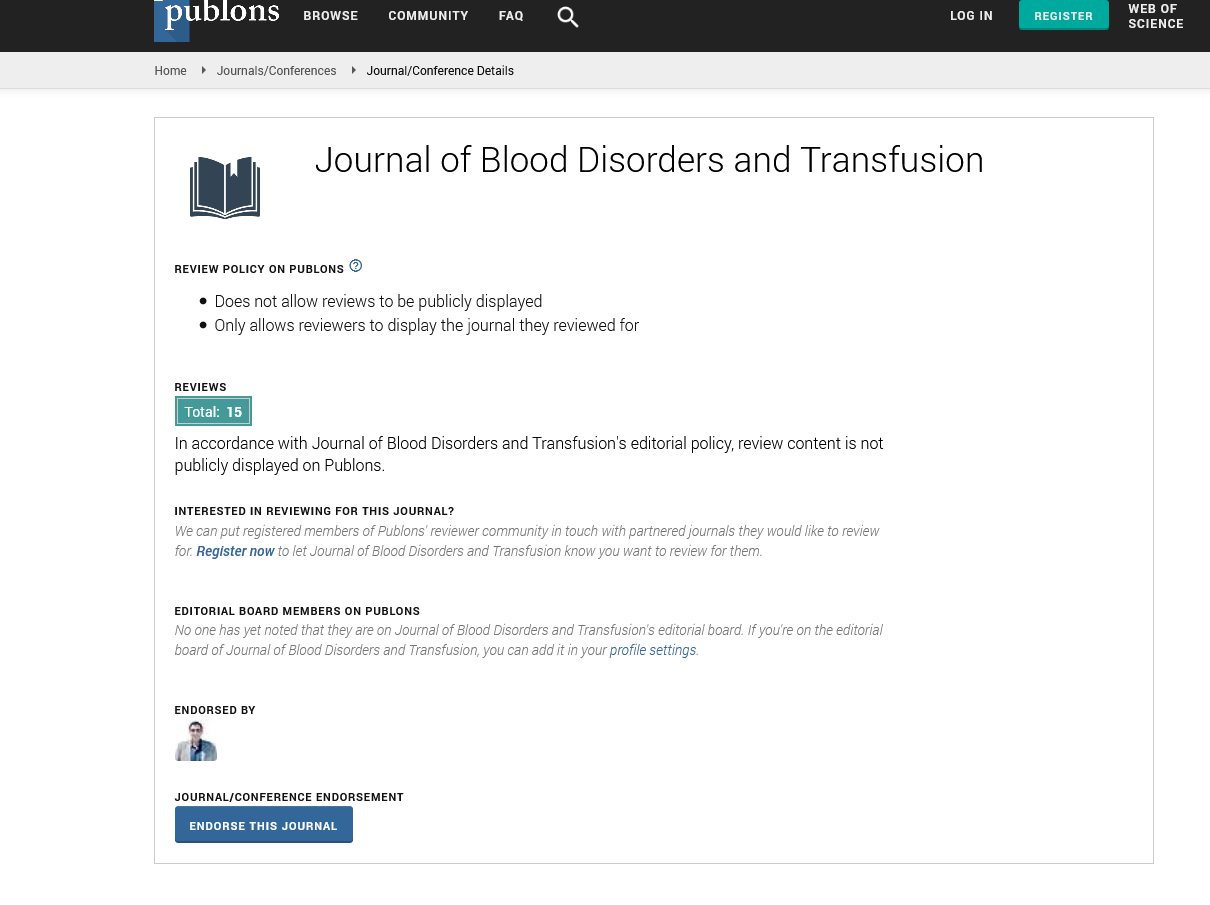Indexed In
- Open J Gate
- Genamics JournalSeek
- JournalTOCs
- Ulrich's Periodicals Directory
- RefSeek
- Hamdard University
- EBSCO A-Z
- OCLC- WorldCat
- Proquest Summons
- Publons
- Geneva Foundation for Medical Education and Research
- Euro Pub
- Google Scholar
Useful Links
Share This Page
Journal Flyer

Open Access Journals
- Agri and Aquaculture
- Biochemistry
- Bioinformatics & Systems Biology
- Business & Management
- Chemistry
- Clinical Sciences
- Engineering
- Food & Nutrition
- General Science
- Genetics & Molecular Biology
- Immunology & Microbiology
- Medical Sciences
- Neuroscience & Psychology
- Nursing & Health Care
- Pharmaceutical Sciences
Short Communication - (2025) Volume 16, Issue 3
Changes in Blood Components Following Donor Red Blood Cell Transfusion in Heart Surgery
Serafina Sciacca*Received: 28-Apr-2025, Manuscript No. JBDT-25-28997 ; Editor assigned: 01-May-2025, Pre QC No. JBDT-25-28997 (PQ); Reviewed: 15-May-2025, QC No. JBDT-25-28997 ; Revised: 22-May-2025, Manuscript No. JBDT-25-28997 (R); Published: 29-May-2025, DOI: 10.4172/2155-9864.25.16.620
Description
Cardiovascular surgery often necessitates Red Blood Cell (RBC) transfusions to compensate for perioperative blood loss and maintain adequate oxygen delivery. Allogeneic RBC transfusions, involving donor blood, are common in such procedures. While these transfusions save lives, they also affect the recipient's immune system, inducing changes in immune cell populations and functions. Understanding immune cell kinetics — the dynamic changes in immune cells over time following allogeneic RBC transfusion — is essential to optimize patient outcomes and minimize adverse effects.
Immune cell changes post-transfusion
After receiving allogeneic RBCs, patients often experience shifts in immune cell counts and function. Studies indicate that several key immune cell populations undergo transient or sustained changes in number and activity.
Neutrophils: Neutrophils are first responders to tissue injury and infection, involved in phagocytosis and the release of reactive oxygen species. Following transfusion, neutrophil counts can rise due to surgical stress and inflammatory stimuli. However, transfused RBCs can also activate neutrophils, leading to a hyperactive state that may contribute to postoperative complications such as acute lung injury. Monitoring neutrophil kinetics helps assess inflammatory status and potential risk of tissue damage [1–3].
Monocytes and macrophages: Monocytes circulate in the bloodstream and differentiate into macrophages in tissues. They play vital roles in antigen presentation and cytokine production. After transfusion, monocyte counts and phenotypes may fluctuate, reflecting immune activation or suppression. Some evidence suggests that allogeneic RBC transfusion may lead to reduced monocyte HLA-DR expression, a marker linked to immunosuppression and higher infection susceptibility.
Dendritic cells: Dendritic Cells (DCs) are professional antigen-presenting cells bridging innate and adaptive immunity. RBC transfusions may impact DC numbers and maturation status, influencing their capacity to stimulate T cells and modulate immune tolerance or activation [4–7].
Clinical implications
Infection risk: Immune alterations post-transfusion may increase susceptibility to infections, a significant cause of morbidity after cardiovascular surgery. Lymphocyte depletion and monocyte dysfunction reduce the host's ability to clear pathogens, while neutrophil activation can cause tissue injury that predisposes to infection.
Inflammation and organ dysfunction: Heightened neutrophil activity and proinflammatory cytokine release can contribute to Systemic Inflammatory Response Syndrome (SIRS) and organ dysfunction, including Acute Respiratory Distress Syndrome (ARDS) and acute kidney injury [8–10].
Postoperative recovery: Immune competence is necessary for wound healing and recovery. Persistent immunosuppression can delay healing and extend hospital stays.
Conclusion
Allogeneic RBC transfusion in cardiovascular surgery patients causes varied changes in immune cell populations and function. Neutrophils, monocytes, lymphocytes and dendritic cells exhibit dynamic kinetics influenced by transfusion characteristics and patient factors. These immune changes impact infection risk, inflammation and recovery.
Comprehensive monitoring of immune cells post-transfusion offers opportunities to improve patient care by anticipating complications and guiding interventions. Continued research will refine understanding of immune kinetics and support development of strategies that optimize transfusion benefits while limiting adverse immune effects.
References
- Ad N, Massimiano PS, Rongione AJ, Taylor B, Schena S, Alejo D, et al. Number and type of blood products are negatively associated with outcomes after cardiac surgery. Ann Thorac Surg. 2022;113(3):748-756.
- Andersen CC, Stark MJ, Kirpalani HM. Thresholds for red blood cell transfusion in preterm infants: Evidence to practice. Clin Perinatol. 2023;50(4):763-774.
- McNamee AP, Simmonds MJ. Red blood cell sublethal damage: Hemocompatibility is not the absence of hemolysis. Transfus Med Rev. 2023;37(2):150723.
- Jacobs JW, Bates I, Cohn CS, Choudhury N, Owusu-Ofori S, Vrielink H, et al. The global blood donation index: An imperfect measure of transfusion need. Lancet. 2024;404(10456):988-990.
- Bohuta L, Chan T, Charette K, Latham G, Greene CL, Mauchley D, et al. Significant reduction in blood product usage, same early outcomes: Blood conservation in infants undergoing open heart surgery. JTCVS open. 2024;22:450-457.
- Ding J, Ding X, Liao W, Lu Z. Red blood cell-derived materials for cancer therapy: Construction, distribution, and applications. Mater Today Bio. 2024;24:100913.
- Ohls RK, Bahr TM, Peterson TG, Christensen RD. A practical guide to reducing/eliminating red blood cell transfusions in the neonatal intensive care unit. Semin Fetal Neonatal Med. 2024.
- Park SM, Rodriguez J, Zhang Z, Miyata S. Review of Low Titer Group O Whole Blood (LTOWB) Transfusion in Initial Resuscitation of Pediatric Trauma Patients: Assessing Potential Benefits. J Pediatr Surg. 2024:161892.
- George EC, Uyoga S, M'baya B, Byabazair DK, Kiguli S, Olupot-Olupot P, et al. Whole blood versus red cell concentrates for children with severe anaemia: A secondary analysis of the Transfusion and Treatment of African Children (TRACT) trial. Lancet Glob Health. 2022;10(3):e360-368.
- Gyi R, Cho BC, Hensley NB. Patient Blood Management in Vascular Surgery. Anesthesiol Clin. 2022;40(4):605-625.
Citation: Sciacca S (2025). Changes in Blood Components Following Donor Red Blood Cell Transfusion in Heart Surgery. J Blood Disord Transfus. 16:620.
Copyright: © 2025 Sciacca S. This is an open-access article distributed under the terms of the Creative Commons Attribution License, which permits unrestricted use, distribution, and reproduction in any medium, provided the original author and source are credited.

